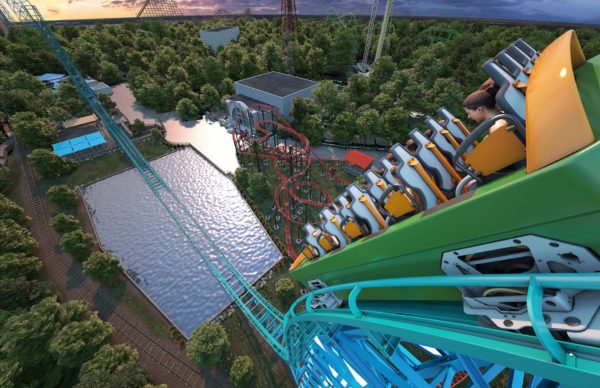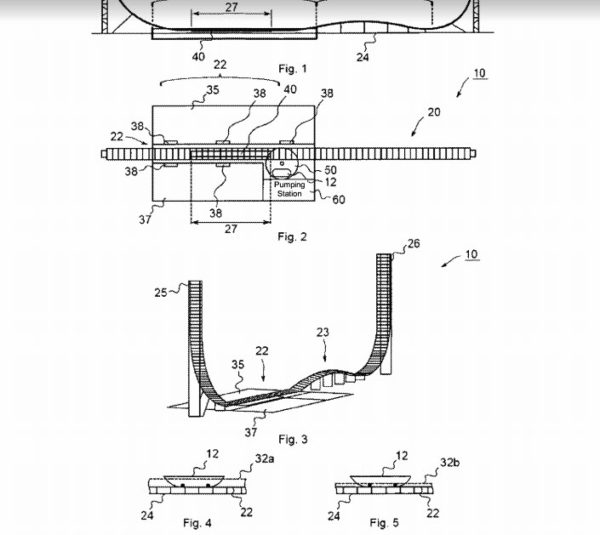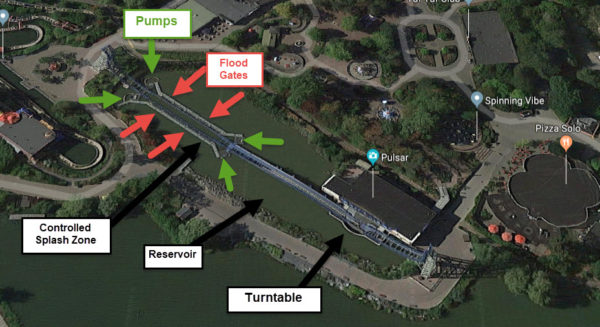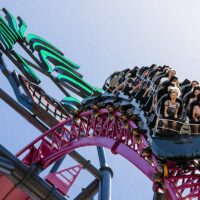Six Flags Over Texas recently announced their 2020 addition will be Aquaman Power Wave, the first Mack Rides Power Splash – a launched shuttle water coaster – to be built in the US. The ride will launch riders backwards, forwards, and backwards again, straight up colossal 148 feet tall twin track towers and then send them plunging straight down into a splashdown finale, as seen in the animation below.
Your first question after seeing the concept video might be: how do they make the splash only at the end of the ride?
How Aquaman Power Wave works
During the 70-second ride, linear synchronous motors (LSMs) launch the boats three times: first backward into a small camelback hill that should provide plenty of airtime throughout the course. The boat stalls out on the first tower and goes forward, over the camelback hill again where the LSMs propel the boat up the front tower. After the final backwards launch the boat reaches a top speed of 62 miles per hour. But how does the grand finale – the splashdown – work?

How the splash works is explained right in the title of the patent Mack rides filed: Water Ride Having A Variable Water Level. In the other common water rides we’re used to, log flumes, shoot-the-chutes, river rapids, etc., the water level is fixed; it doesn’t change. Here’s what makes the Power Splash unique: the vehicle can pass through an area with a raised or lowered water level. We’ll call this the “splash zone.”
How does the splash pool get filled and how is the water level controlled?

The secret is the water is divided up into two regions: the main reservoir which can hold all of the water, and the splash zone where the track passes through. The reservoir initially holds the majority of the water, meaning the water level in the splash zone is at a lower level (or could even have no water), allowing the vehicle to pass through with little or no resistance. When the control system gives the signal, flood doors (or sluice gates) in the reservoir are opened allowing water to quickly pour into the splash zone, raising the water level to a predetermined height very quickly.
As the boat enters the reverse spike for the last time, the pool at the base of the spike fills with water in roughly six seconds. The boat careens down the spike and into the pool of water, which acts as a natural brake.
After the car passes, the flood gates are closed and pumps are used to pump the water out of the splash area and back into the reservoir. This may seem inefficient at first, but I would expect the pumping required is much less than a typical river raft ride which has to constantly pump a large amount of water from the lowest point of the ride to the highest.
Pulsar at Walibi Belgium
There is currently one Power Splash in operation, Pulsar at Walibi Belgium, and thanks to it we can see an excellent video of the splash zone filling with water, exactly how Aquaman Power Wave works.
Notice the gates opening and closing and then the water getting pumped out towards the end?
As you can see, almost the entirety of the Pulsar ride sits above the water reservoir, but only the splash zone is highly controlled.

Another key difference is Pulsar is able to operate two 20-seat boats simultaneously, thanks to a rotating station turntable. While one boat is loading/unloading, the other completes the ride cycle. Unfortunately, it looks like Aquaman Power Wave does not have this feature and thus will only operate one boat.
Update 12/14/21: Since Aquaman was delayed until 2022 due to the pandemic, the delayed opening was actually a good thing in this case as a turntable was added to the coaster in order to run two vehicles as opposed to just one, thus increasing the capacity.
Future Variations of the Power Splash Model
Although the way the Power Splash works is by controlling the water level and not raising and lowering the tracks, the patent does call out both methods.
It is also within the scope of the present invention for the water level in the route segment to remain constant and for the system of rails provided along the route segment on which the vehicles are guided to be raised or lowered. However, this variant is significantly more costly to implement.
So there you have it. You could raise and lower the coaster rails but it would be more expensive.
The current model is a shuttle coaster, one where the vehicle goes back and forth on a short section of track, but future Power Splash models could be a full circuit coaster with possibly even a shuttle-like segment. The patent also mentions the track doesn’t have to be two rails. It could be for any vehicle guided by magnetic strips, cables, or even a U-shaped bobsled type track (think a water slide coaster shuttle coaster with this splash element).
Now you know how Aquaman Power Wave works. What other parks in the US could use a Mack Power Splash coaster? Let us know your thoughts in the comments below.














You think they would be willing to pay more money and have the turntable option as opposed to only having one boat and killing the ride capacity.